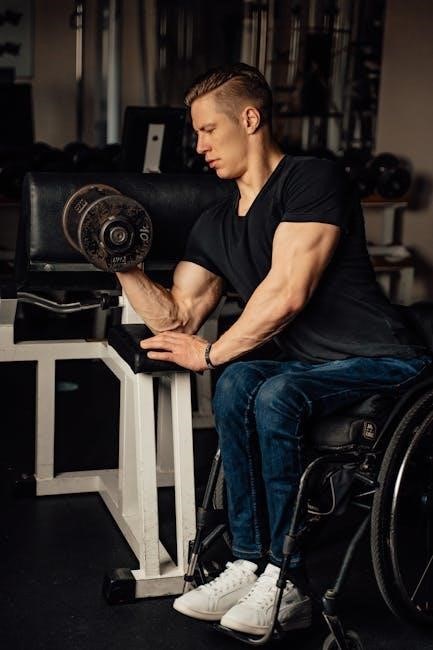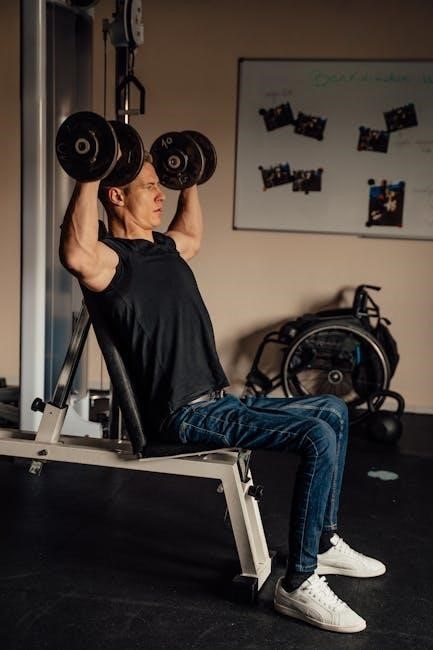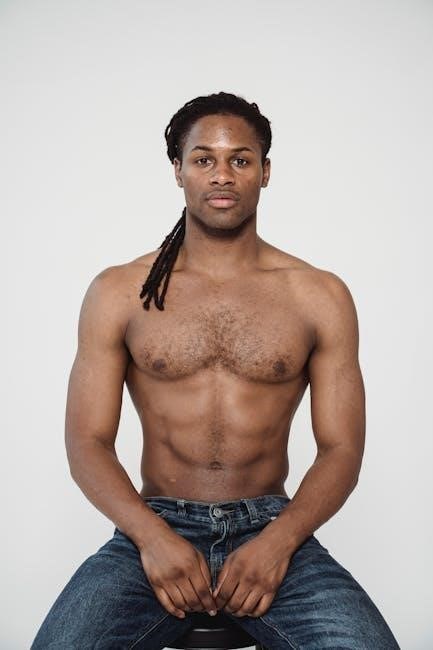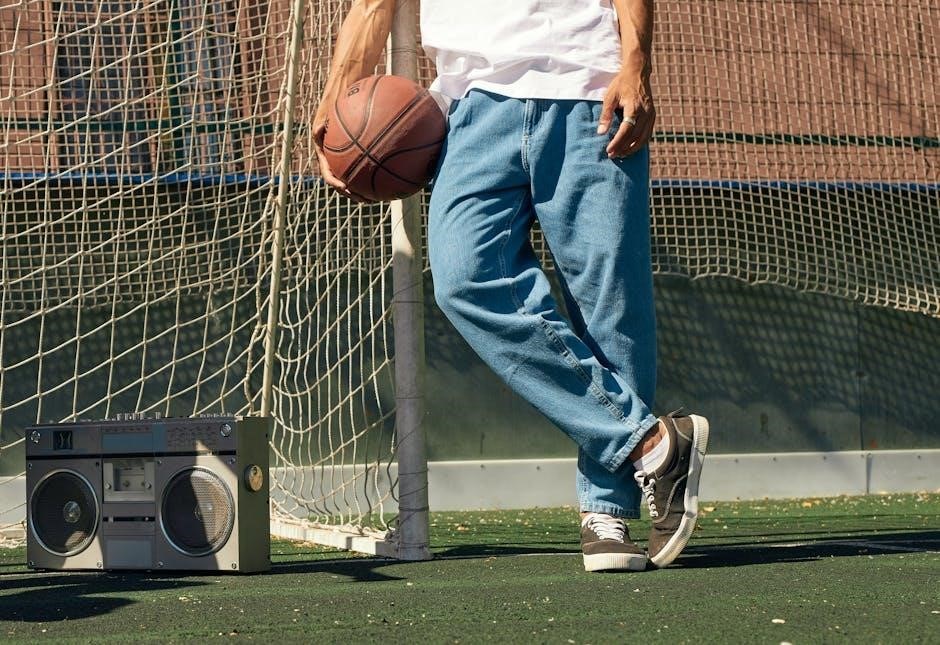Navigating the complexities of finding the perfect pair of jeans can be overwhelming, but understanding the basics of fit, style, and personalization makes it manageable.

1.1 Understanding the Importance of Fit in Men’s Jeans
Finding the right fit in men’s jeans is crucial for both style and comfort. A well-fitted pair enhances your silhouette, boosting confidence and creating a polished look. Poor fit, on the other hand, can make even the most stylish jeans appear unflattering. The right fit ensures jeans drape correctly on the body, avoiding sagging or constriction. It also impacts how the jeans move with you, making everyday activities more comfortable. Whether you’re aiming for a classic or modern style, understanding your body type and how jeans should sit on your waist, hips, and legs is essential. This foundation is key to building a wardrobe staple that feels as good as it looks.
1.2 Key Factors to Consider When Choosing Jeans
When selecting the perfect pair of jeans, several key factors come into play. First, consider your body type to determine the most flattering styles, such as slim, straight, or relaxed fits. Next, think about the rise—high, mid, or low—to ensure comfort and desired aesthetics. Inseam and pant length are also critical, as they affect how the jeans break on your shoes. Fabric choice is another essential element; denim weight and stretch can impact both comfort and durability. Additionally, personal style and how the jeans will be paired with other wardrobe items should guide your decision. By focusing on these elements, you can narrow down the options and find a pair that meets your needs and preferences perfectly.

The Key Elements of a Perfect Fit
A perfect fit combines rise, inseam, leg shape, and fabric quality to ensure comfort and style, catering to individual body types and personal preferences seamlessly.
2.1 Rise: High, Mid, or Low – What’s Right for You?
The rise of your jeans determines how they sit on your waist and hips. A higher rise offers a classic look, elongating the torso and providing more coverage, ideal for taller men or those with larger builds. Mid-rise jeans strike a balance, sitting just below the natural waistline, making them versatile for most body types. Low-rise styles are trendier, sitting lower on the hips, best suited for slimmer frames. Choosing the right rise depends on your body type and personal style. Pair high-rise jeans with tucked-in shirts for a polished look, while low-rise styles work well with modern, casual outfits. Experiment with different rises to find what flatters your physique and aligns with your wardrobe goals.
2.2 Inseam and Pant Length: How They Impact Fit
Inseam and pant length are crucial for achieving the perfect fit in men’s jeans. The inseam, measured from the crotch to the bottom of the pant leg, determines how the jeans break on your shoes. A longer inseam creates a fuller break, ideal for boots or those seeking a relaxed look, while a shorter inseam offers a clean, streamlined appearance, perfect for sneakers. Pant length should align with your shoe style to avoid excessive bunching or a too-tight fit. Proper inseam and pant length ensure comfort and style, preventing awkward draping or restriction. Balancing these elements with your body type and lifestyle is key to a polished, tailored look.

2.3 Leg Shape: Slim, Straight, or Relaxed Fit
Choosing the right leg shape—slim, straight, or relaxed—is essential for a flattering fit. Slim-fit jeans hug the legs tightly, creating a modern, streamlined look, ideal for lean builds or contemporary styles. Straight-leg jeans offer a balanced fit, neither too tight nor too loose, making them versatile for various body types. Relaxed-fit jeans provide more room through the thigh and leg, offering comfort and a casual appearance, suitable for broader builds or those preferring a laid-back style. Each leg shape complements different body types and fashion preferences, ensuring a tailored look that enhances your overall aesthetic. Selecting the right leg shape ensures both comfort and style, making it a critical factor in your jeans selection.
2.4 Fabric: Denim Weight and Stretch for Comfort
Fabric plays a crucial role in determining comfort and durability in men’s jeans. Denim weight, measured in ounces, varies from lightweight (9-12 oz) for warm weather to heavy-duty (16 oz+) for durability. Lighter fabrics offer breathability, while heavier ones provide structure and longevity. Stretch denim, infused with elastane, enhances flexibility, making it ideal for active lifestyles or those seeking a modern fit. Non-stretch denim offers a classic, rigid feel, perfect for traditional styles. Balancing weight and stretch ensures comfort and functionality, catering to different preferences and activities. Always consider your lifestyle and needs when selecting fabric to ensure optimal comfort and satisfaction.

Common Mistakes to Avoid When Buying Jeans
Common mistakes include buying the wrong size, ignoring body type, and overlooking fabric quality. Ensure proper fit, consider personal style, and prioritize comfort for the best results.

3.1 Buying the Wrong Size for Your Body Type
One of the most common mistakes when buying jeans is selecting the wrong size for your body type. Ready-to-wear clothing is often designed for an “imaginary” body, and sizes can vary significantly between brands. Many men overlook the importance of proper measurements, leading to jeans that are either too tight or too loose. To avoid this, it’s crucial to know your measurements and understand how different styles flatter your physique. For example, taller men may prefer longer inseams, while shorter men should opt for shorter lengths to create a balanced look. Always consider your body type—slim, athletic, or relaxed—and try jeans on if possible to ensure the best fit.
3.2 Ignoring the Importance of Body Type
Ignoring your body type is a critical error when selecting jeans. Each body type—whether slim, athletic, or larger—benefits from specific fits and styles. Slim-fit jeans, for instance, complement lean frames, while relaxed fits accommodate broader builds. Understanding your body type ensures jeans drape correctly and create a flattering silhouette. For example, men with shorter torsos should avoid high-rise styles that elongate the waist, while those with longer legs can balance proportions with straight-leg cuts. Neglecting body type often results in an unpolished look, making it essential to align your jeans choice with your physique for optimal comfort and style. Always consider how different rises, inseams, and leg shapes enhance your natural proportions.
3.3 Overlooking Fabric Quality and Comfort
Overlooking fabric quality and comfort is a common mistake when buying jeans. Denim weight, stretch, and breathability significantly impact wearability. Heavy denim may be durable but less comfortable in warmer climates, while lightweight fabrics offer coziness but may lack structure. Stretch jeans provide flexibility, ideal for active lifestyles, but excessive stretch can compromise shape retention. Neglecting fabric quality often leads to discomfort or premature wear. Prioritize fabrics that align with your lifestyle—whether sturdy cotton for durability or Tencel for softness. Ignoring comfort can result in jeans that are rarely worn, emphasizing the importance of balancing style with practicality. Always consider how the fabric feels and performs before making a purchase.

Styling Tips for Different Jeans Fits
From classic to modern, styling jeans involves pairing fits with occasion and personal aesthetics. Explore timeless looks, incorporate trends, and adapt styles for every season seamlessly.
4.1 Classic Style: Timeless Pairing Ideas
Classic styling revolves around simplicity and versatility. Pair high-rise, straight-leg jeans with a crisp white T-shirt for a timeless look. Add a leather jacket for a rugged touch or a blazer for sophistication. Slim-fit jeans work well with fitted sweaters or button-down shirts, creating a polished yet understated appearance. For a casual vibe, combine relaxed-fit jeans with a plain tee and sneakers. Accessories like a minimalist watch or a simple bracelet can elevate the outfit. The key is to balance proportions and focus on clean lines. This approach ensures versatility, making it suitable for various occasions, from daily errands to dinner dates. Classic styles endure because they prioritize comfort and effortless elegance, allowing personal touches to shine through.
4.2 Modern Style: Trends to Incorporate
Modern styling embraces current trends while maintaining a sleek, contemporary aesthetic. Slim-fit or tapered jeans are ideal for a streamlined look, paired with graphic tees or oversized sweatshirts for a casual yet fashionable vibe. Incorporate utility jackets or bomber jackets to add an edgy touch. Sneakers, particularly chunky or retro styles, complement modern jeans perfectly. Accessories like crossbody bags or beanies can enhance the outfit. For a refined modern look, try pairing straight-leg jeans with a fitted polo shirt and loafers. Balance trends with personal style to ensure comfort and confidence. Modern fashion encourages experimentation, so don’t hesitate to mix and match pieces to create a look that feels fresh and current while reflecting your individuality.

4.3 Seasonal Styling: Jeans for Every Time of Year
Jeans are versatile and can be styled for any season with the right approach. In spring, opt for lighter washes and pair them with pastel-colored shirts or lightweight jackets for a fresh look. Summer calls for breathable fabrics like stretch denim, paired with linen shirts and sandals. Autumn is perfect for darker washes, earthy tones, and layering with sweaters or leather jackets. Winter styling involves thicker denim, thermal underwear, and chunky knitwear. Regardless of the season, accessorizing appropriately—such as adding scarves in winter or a hat in summer—can elevate your look. By adapting your jeans to seasonal trends and layering wisely, you can enjoy a stylish wardrobe all year round.
The perfect pair of jeans is within reach when focusing on fit, fabric, and personal style. This guide ensures your jeans become a timeless wardrobe staple, making the search worthwhile.

5.1 Final Tips for Finding Your Perfect Pair
When searching for your ideal jeans, prioritize fit, fabric, and personal style. Consider your body type, as certain rises and leg shapes flatter different physiques. Higher rises can elongate torsos, while slim legs streamline silhouettes. Fabric choice matters too—opt for denim that balances comfort and durability. Don’t overlook inseam and pant length, ensuring they complement your shoe style. Experiment with trends but invest in timeless classics. Remember, the right fit enhances confidence and comfort. Take your time, try options, and seek tailored advice if needed. Your perfect pair should feel like a second skin, blending seamlessly into your wardrobe for years to come.



